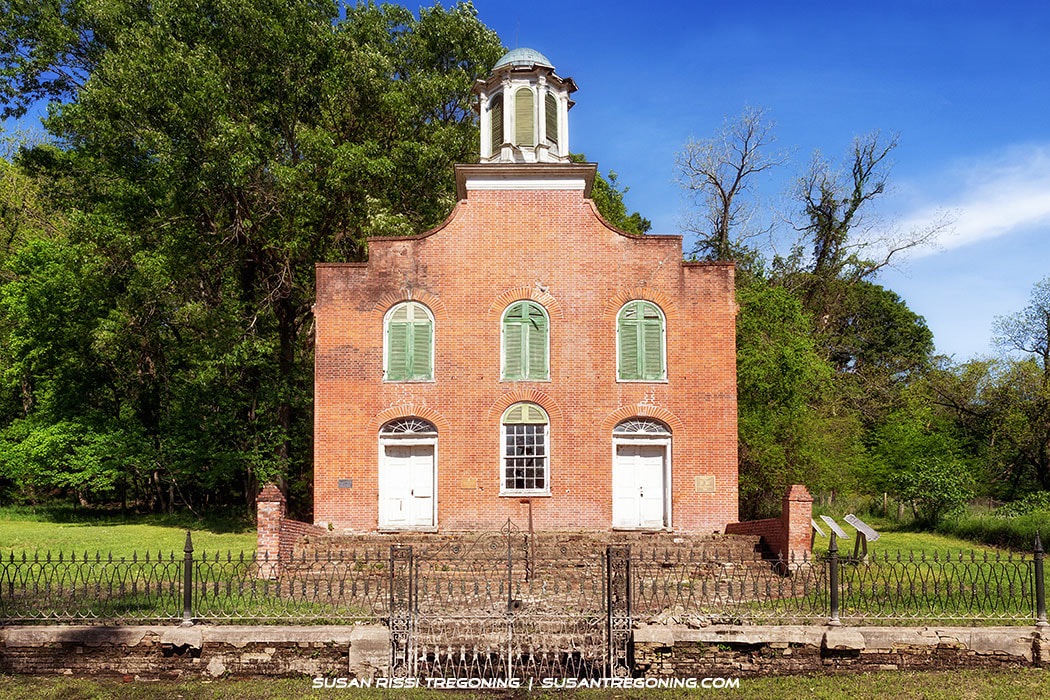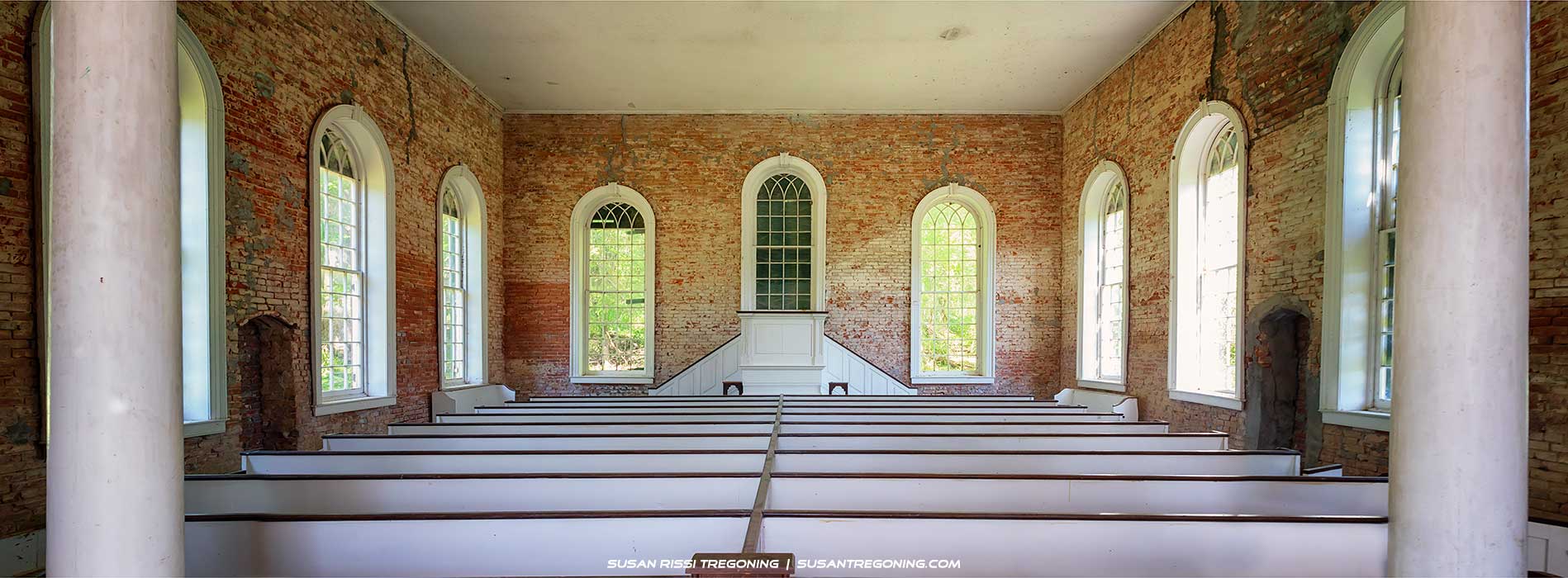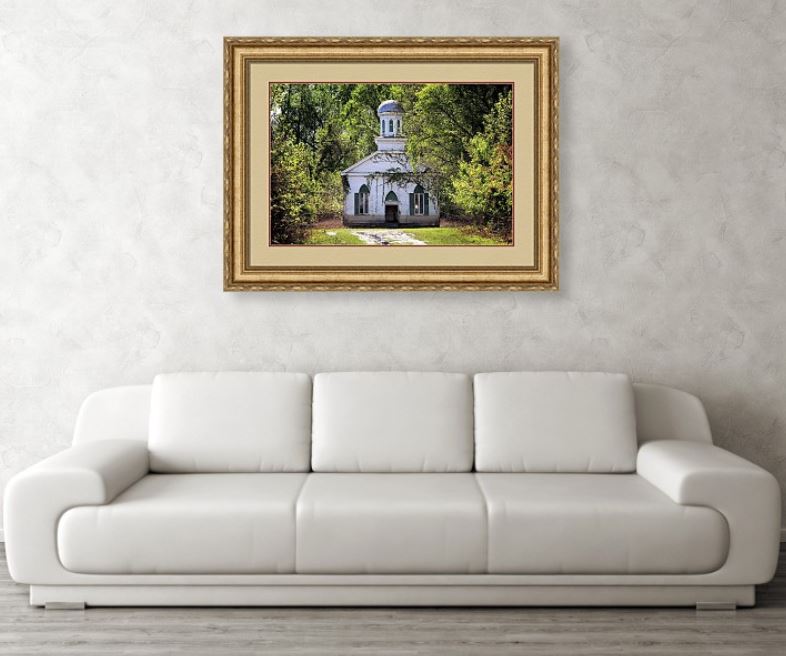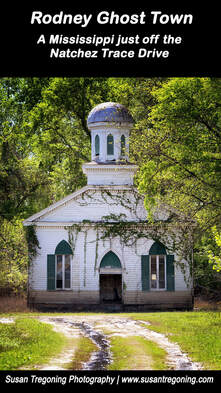|
Located just outside of Lorman, Mississippi and a short distance off the Natchez Trace Parkway is the ghost town of Rodney, Mississippi. Not much is left of this early nineteenth-century river settlement that is richly steeped in early American history. It is now all but forgotten and only visited by the most adventuresome travelers.
I first fell in love with an old black and white photograph of the Rodney Baptist Church many years ago placing Rodney Ghost Town high on my bucket list of places to photograph in Mississippi. Let me just say, it didn't disappoint! A Brief History of Rodney
Although the town of Rodney, Mississippi is little known to history, it is one of the oldest settlements in Mississippi. As early as 1763, there was a French settlement here called Petit Gouffre (Little Chasm). After the French and Indian War, it became the domain of Great Britain. Then Spain, after it captured British West Florida in 1781. The area was known as Little Gulf by then. Although it was not really a gulf, it was a convenient river crossing first discovered and used by the Indians. By 1798, when Spain deeded it to Thomas Calvit, a prominent Mississippi Territorial landowner, the area was already considered prosperous.
From 1820 to 1860, Rodney was booming, and it finally incorporated into the town of Rodney in 1828. Strategically located on the lower terrace of the Loess Bluffs the relative steepness of the riverbanks here on the Mississippi River made it an ideal landing for riverboat transportation. It flourished as a vital river community becoming a center for commerce that rivaled Natchez. With its proximity to Oakland College, present-day Alcorn State University, it became a town of intelligence and culture settled by physicians, lawyers, and wealthy plantation owners. It almost became the first capital of the Mississippi Territory only losing out to Natchez by three votes. By the 1840s, it was the busiest port between New Orleans and St. Louis, and an important port of call for riverboats traveling the Mississippi. When Rodney peaked in the 1860s, around 4,000 people were living here; it had two banks, two newspapers, four churches, and approximately 35 stores. It was home to the first opera house in the state. Plays as good as anything you could attend in New York, or Philadelphia could be seen here.
Ill-fated Rodney sustained a series of disasters. A yellow fever epidemic in 1843 and a fire in 1852, hit the town hard. By the beginning of the Civil War on April 12, 1861, Rodney was already declining. A sandbar had formed in the Mississippi River causing the river to alter its course two miles to the west putting an end to the riverboat economy here. A second fire in 1869, destroyed the northern section of town, but it was in such a decline by then no attempt was ever made to rebuild. By 1870, Rodney was relatively abandoned. The final bell tolled in 1880 when the railroad decided to build East thought Fayette causing all of the cotton shipments to bypass the town. Another yellow fever epidemic swept through in 1898; this time it didn’t last long since almost everyone was already gone. In 1930, by executive proclamation, the 102-year-old town of Rodney was abolished.
Today, even though a small number of inhabitants remain, Rodney is considered a ghost town. * All of Rodney is privately owned, please be respectful if you decide to visit. * Famous People Around Rodney
Dr. Rush Nutt, one of the three Oakland College founders, was also a prominent plantation owner and doctor in the area. He developed the Mexican strain of cotton known as Petit Gulf variety that became popular in the 1830s. This cotton was easy to pick, immune to rot, and produced superior quality fibers. He improved on the design of the Whitney Cotton Gin by adding flumes for sorting dirt from the staples. He was also the first to use a steam engine to drive cotton gins. Dr. Nutt encouraged farmers to plant peas as fertilizer and to plow cotton and corn stalks under instead of burning the fields. He popularized contour or horizontal plowing to prevent the loess soil hillsides from erosion.
In the late 1830s, General Zachary Taylor, the nation’s future 12th President (1849-1850) was so taken with Rodney that he decided to purchase land nearby. I speculate it was a way to be closer to the memory of his daughter Sarah, who had eloped with Jefferson Davis, the future president of the Confederate States, in 1835 only to die of malaria just three months later. Taylor’s new plantation was located a few miles south of Rodney and just upriver from Jefferson Davis’s plantation, Davis Bend. Taylor purchased Cypress Grove Plantation in 1842, after selling his other properties in Louisiana and Mississippi, renaming it the Buena Vista Plantation. Zachary Taylor and his wife often visited before he was elected president, but once in office he never made it back to the Rodney area dying in office just a year later. The Presbyterian Church's Civil War History
The Rodney Presbyterian Church building was built in 1830-31 in the Federal architectural style with red bricks, rounded archives, a stepped gable roof, and an octagonal bell tower. It was dedicated January 1, 1832, with Reverend Doctor Jeremiah Chamberlain, the founder, and president of Oakland College, preaching the service.
On Sunday morning, September 13, 1863, a skirmish took place at this church. The Union's USS Rattler gunboat was docked in Rodney, and Reverend Baker, a northern sympathizer, invited the crew to attend church services. Violating the Sunday truce, a small party of Confederate soldiers arrested them. When word reached the Rattler, the gunboat bombarded the town and church. The Confederates sent word that if shelling did not stop; they would hang all the prisoners. Four houses and the church were hit during the skirmish, but overall there was not much damage. The story about Rodney and the Rattler spread quickly, soon the Rattler’s crew was the laughingstock of the nation. Reverend Baker quickly left town, and a few months later the Union soldiers were exchanged for some captured Rebel soldiers. Almost exactly a year later, Union troops arrived back in Rodney to destroy a “concentration of Confederates” in Rodney. Almost every house was plundered, and the land was stripped of food, livestock, and slaves by the Union. Rodney may have been spared from battle, but the Civil War still left its mark.
The church still bears scars from the shelling, notice the cannonball above the second-floor center window. The cannonball seen today is a replica added during the Presbyterian Church's first renovation. The church has been listed on the National Register of Historic Places since 1973.
In 2018, Rodney History & Preservation Society purchased the Rodney Presbyterian Church from the United Daughters of the Confederacy. They are in desperate need of donations to save the church from structural collapse. If you would like to donate, more information can be found on their website.
While not flooded when I visited, the ground was very marshy, and the church looked as if it were drying out from another recent flooding. There is a visible waterline on the outside of the church, but I did not get close enough to look inside. I’m afraid this beauty will not be with us much longer if something isn’t done to save her.
One Church Saved
It was placed on the National Register of Historic Places in 1972 and is widely considered the finest example of Carpenter Gothic church architecture remaining.
In 1983, in an effort to save this architecturally significant church, the Rodney Foundation donated it to the State of Mississippi. It was moved to the Grand Gulf Military Park near Port Gibson, Mississippi that same year. The church has since been beautifully restored and is now used as a non-denominational chapel. They have renamed it the Confederate Memorial Chapel.
If you would like to visit the Confederate Memorial Chapel AKA Sacred Heart Roman Catholic Church at Grand Gulf Military Park, check their Facebook page before visiting. The Church and grounds sit high on a hill but the road into the park floods frequently. The park is good about posting closure notices there. A map, direction and hours can be found on the Grand Gulf Military Park website.
Finding Rodney Ghost Town
DO NOT trust your GPS for directions to Rodney. The GPS will take you through the grounds of Alcon University and out a little used back gate where there is a narrow dirt road that looks like it was last graded in the 1820s. While this might be fun, if you have a high clearance 4WD, there is a much easier way to get there. I imagine, this was the road the college’s founding fathers used when commuting. Trust me on this one, I really wanted to drive it because of it's history and while my husband and I have had our SUV in some pretty unbelievable places, we turned less than a 1/3 of a mile down the road.
Instead, use these directions to Rodney Ghost Town:
You can find more of Susan's Mississippi Travel Photography in the Mississippi Collection in her Gallery.
See anything you like? Susan's work is available for purchase here: The Gallery. Images are available as wall art, fine art prints, on home decor, gift items and apparel.
0 Comments
Your comment will be posted after it is approved.
Leave a Reply. |
AuthorI am the 8th photographer in 4 generations of my family. Back in 2006, my husband accepted a job traveling, and I jumped at the chance to go with him. Categories
All
Archives
June 2024
This website uses marketing and tracking technologies. Opting out of this will opt you out of all cookies, except for those needed to run the website. Note that some products may not work as well without tracking cookies. Opt Out of Cookies |













 RSS Feed
RSS Feed